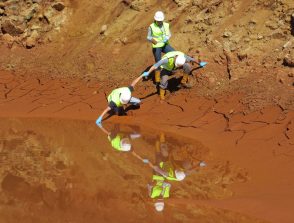Characterization and remediation by non-Newtonian fluids of soils contaminated with light hydrocarbons under water table variations
Definition and development of the optimal polymer solution for the purpose of petroleum hydrocarbons polluted soil remediation.
Start: 01 January 2023
End: 01 January 2026
Supervisors :
Eric van Hullebusch, Stefan Colombano, Hossein Davarzani, Sagyn Omirbekov
Status: In progress
Accordingly, the rationale behind the concept of injecting non-Newtonian fluid into LNAPL contaminated aquifers is to improve the mobilization of this residual LNAPL compared to conventional remediation technologies based on water injection and pumping. Preliminary studies have shown the advantage of this approach due to favorable viscosity ratios between phases and a stabilization of injection fronts. The project also aims at studying secondary fundamental processes that control the distribution of LNAPL with groundwater table variations and its mobility. It will result in the definition of a methodology allowing to select optimal polymer concentration with respect to the nature of the LNAPL contamination and the main properties of the contaminated soil. All studies will be considered at a laboratory scale using 1D column and 2D tank experiments. These experimental results will be used to adapt and calibrate existing numerical models to simulate multiphase flow in porous media and to identify optimal flow regimes for LNAPL mobilization. The potential of enhancement technologies, such as adding surfactants with polymers, to increase the LNAPL mobility, will also be investigated.
The effectiveness of remediation depends on the form in which LNAPL is present in soils and aquifers. Fluctuations in the water table cause drainages and imbibitions which displace the floating layer (LNAPL as free phase) and create residual saturation (insular and pendular). It is planned to better understand the impact of watertable level changes on hydrocarbon release mechanisms in groundwater, and to evaluate and to characterize the LNAPL saturation distribution in soils (using an imaging technique, in situ probes ….).




